Unwinding of the Yen Carry Trade, Unravels Global Stock Markets
Currencies / Yen Carry Trade Mar 13, 2007 - 11:02 AM GMTBy: Gary_Dorsch
 Millions of words have been written about the heavy handed tactics of Japan’s Ministry of Finance (MoF) in manipulating the value of the Japanese yen, the Japanese bond market, and squeezing short sellers in the Nikkei-225 futures market. Manipulation of markets through the use of jawboning, re-jigging of inflation statistics, and outright intervention is a time honored tradition at the MoF.
Millions of words have been written about the heavy handed tactics of Japan’s Ministry of Finance (MoF) in manipulating the value of the Japanese yen, the Japanese bond market, and squeezing short sellers in the Nikkei-225 futures market. Manipulation of markets through the use of jawboning, re-jigging of inflation statistics, and outright intervention is a time honored tradition at the MoF.
Japan’s Ministry of Finance is a political, economic, and intellectual force without parallel, and with a greater concentration of power than any branch of government amongst the major industrialized democracies. In Japan, there is no institution with more power, and it has a borrowing ceiling for foreign exchange intervention of up to 140 trillion yen ($1.2 trillion) for the upcoming fiscal year.
 So if US Treasury chief Henry Paulson was looking for a quick fix to rescue the Dow Jones Industrials from crashing below the psychological 12,000-level, his visit to Tokyo’s Financial Warlords on March 6th, was perfectly timed. The US dollar was plummeting towards 115.25-yen, when Paulson arrived at MoF headquarters in Tokyo. “Yen carry” traders borrowed an estimated 40 to 70 trillion yen ($350-600 billion) and channeled much of the funds into commodities and stocks around the globe.
So if US Treasury chief Henry Paulson was looking for a quick fix to rescue the Dow Jones Industrials from crashing below the psychological 12,000-level, his visit to Tokyo’s Financial Warlords on March 6th, was perfectly timed. The US dollar was plummeting towards 115.25-yen, when Paulson arrived at MoF headquarters in Tokyo. “Yen carry” traders borrowed an estimated 40 to 70 trillion yen ($350-600 billion) and channeled much of the funds into commodities and stocks around the globe.
But the “yen carry” trades were going sour, when the yen suddenly zoomed 5% higher.
US stocks lost $837 billion of value in the five-day period ended March 2nd, amid a worldwide rout that began in Hong Kong. The sudden unwinding of the “yen carry” trade had whacked $1.5 trillion of value from global stock markets, threatening the global economy.
The infamous “yen carry” trade stopped generating rewards, soon after the Group of Seven central bankers warned on February 10th, that speculators could get burned by one-way bets against the yen. Then, under heavy pressure from angry European finance ministers who are fed up with Tokyo’s six-year “cheap yen” policy, the Bank of Japan hiked its overnight loan rate to 0.50%, its highest level in 10-years, to stop the slide in the Japanese yen against the Euro and US dollar.
While the BoJ’s rate hike put a floor under the yen, it wasn’t enough to push the low yielding currency higher. What lifted the yen sharply higher, and ignited the global stock market shake-out, were meltdowns in share prices of US sub-prime mortgage lenders, and fears the weakening US housing sector could topple the US economy. Former Fed chief “Easy” Al Greenspan put the odds of a US recession at 1:3.
Carry traders were losing an estimated $10 to $12 billion on over-extended short yen positions, and it was looking very bleak for the global stock markets until the US dollar suddenly found support at 115-yen and the Euro bottomed at 150-yen. Did the Bank of Japan intervene in the currency markets on March 6th, at the request of US Treasury chief Paulson, to stop the surge in the yen? Did the BoJ and the US Treasury intervene to support the Japanese and US stock markets last week?
The Nuts and Bolts of the “Yen Carry” Trade
Before examining the latest Japanese MoF and US Treasury intervention tactics, it’s important to understand how the “yen carry” trade works. It’s simple to understand, and it’s not just hedge funds and international bankers who engage in the trade. Many brokerage firms offer margin loans at near 1% in Japanese yen, which are re-invested by their clients to buy stocks around the world.
The “yen carry” trade is primarily a simple game of interest rate arbitrage. Step 1: Borrow yen at 0.5% and convert the yen into $9,000 US dollars. Step 2: With $9,000 from Japan and $1,000 of your own money, invest $10,000 in US Treasury notes at 5.00%. Step 3: Collect $500 in interest from the US Treasury, and pay $45 to the Japanese lender. Step 4: Pocket the $455 difference as a profit, for a rate of return of 45.5% on your original $1,000. Step 5: Sell the US Treasury note, and convert the US dollars back into Japanese yen to pay off your loan.
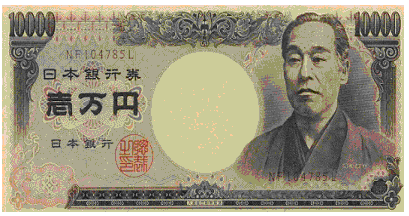
Step 5 is the tricky part, because if the yen were to suddenly surge by 5% against the US dollar, the principal amount of the yen loan would also climb 5% from $9,000 to $9,450, which would wipe out the $455 profit from the interest rate spread. It would be nice to buy yen futures as a hedge against a climbing currency. The problem is that yen futures trade at a hefty premium to the cash market price.
Locking into a yen futures contract at say a 4.5% premium to the cash price would wipe out the profit from the interest rate differential between the two currencies. So carry traders must take on currency risk to play the game, which can go very wrong, if the yen suddenly shoots higher. And that’s what happened earlier this month, when the Japanese yen suddenly surged by 5% against the Euro and US dollar, until US Treasury chief Paulson huddled with Tokyo financial warlords on March 6th.
On February 10th, G-7 central bankers had warned traders against the practice of borrowing vast amounts in low-yield currencies such as the yen and Swiss franc to reinvest for a profit elsewhere. “We want the markets to be aware of the risks of one-way bets, in particular on the foreign exchange market. One-way bets in the present circumstances would not be appropriate. We want the markets to be aware of the risks they contain,” said European Central Bank chief Jean “Tricky” Trichet.
Japanese Finance Minister Koji Omi was singing from the same song book. “This means that G-7 countries think that markets, particularly foreign exchange markets, should recognize the risk of moving in one direction too heavily. I think we have come to the appropriate conclusion,” he said. And when the chief of the powerful Japanese ministry of finance speaks, currency traders listen but don’t always obey.
European Central Bankers demand a Stronger Yen
Aided by the Euro’s strength against the yen, Japanese exports to the European Union nearly doubled to 1.06-trillion yen in December. But on the flip side, European exports to Japan have waffled between stagnation and deterioration. While Japan is a small market for European exporters, Euro zone finance ministers understand that its exporters will suffer badly in world markets because of cheap competition from Japan in addition to cut-throat competition from China.
“I will read again what we just said in Essen, we reaffirm that exchange rates should reflect economic fundamentals,” said ECB chief Trichet at the Amsterdam Chamber of Commerce and Industry on Feb 15th. “We believe that the Japanese economy is on a sustainable economic path and that exchange rates should reflect these economic fundamentals,” Trichet added.
Earlier on Jan 31st, Bank of France chief Christian Noyer said there was room for the Bank of Japan to raise its interest rates carefully. “I’m concerned about developments in the yen. The yen exchange rate is not in line with an improvement in the Japanese economy and its strength. Japan is one of the engines to drive global growth. A weak yen will cause distortion in the world economy in the medium term. However, I think the market will correct it in an autonomous manner,” he concluded.
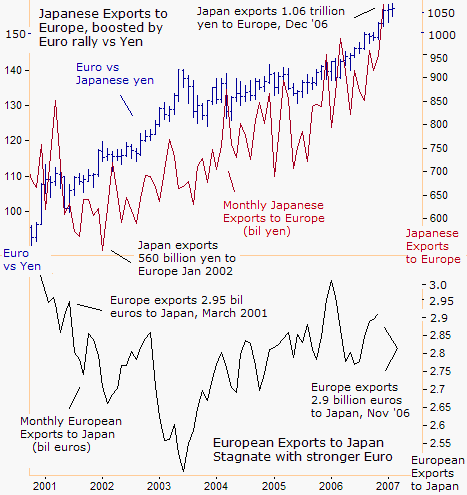
So last month, European finance ministers demanded and received an interest rate hike from the Bank of Japan to 0.50%, to stop the slide of the yen. For his part, US Treasury chief Paulson was opposed to Europe’s idea of pressuring Japan for a rate hike, and instead was content with Tokyo’s cheap yen policy. “I may be looking at it a bit more carefully only because of the publicity coming out of Europe. But from my standpoint, the yen’s value is set in a competitive marketplace,” he said on Feb 1st.
On Feb 14th, Federal Reserve Chairman Ben Bernanke aligned himself squarely with Paulson before the Senate Banking Committee. “We don’t see any manipulation or intervention in the value of the yen. The Treasury and Federal Reserve have expressed a view that exchange rates ought to be determined in free and open markets. As best we can tell, the yen’s value is being determined in a free, open, competitive market. There is no evidence of any intervention going on.”
Yet Bernanke’s testimony coincided with an announcement by DaimlerChrysler that it was slashing 13,000 jobs at its North American car plants, bringing the loss of US auto manufacturing jobs to 80,000 over the past 12-months. “The last time the Japanese purchased dollars was in March 2004,” Bernanke quipped. The disintegration of the US manufacturing base is the price that the US Treasury is willing to pay in return for cheap credit from China, Japan, and South Korea.
But European finance ministers were not buying the US Plunge Protection Team’s propaganda and demanded that Japan begin to lift its abnormally low interest rates into alignment with the rest of the world. Four weeks later, the yen carry trade began to unravel, triggering widespread selling of commodities and stocks around the globe by over-extended speculators, banks, and hedge funds.
Brief history of Japanese MoF Intervention in the Yen
There are many tricks of the trade that the US Treasury’s Plunge Protection Team can learn from Tokyo’s Financial Warlords, who have decades of experience in hand to hand combat with nasty currency speculators and bearish stock market operators. Tokyo’s MoF has acquired $875 billion of foreign currencies through its intervention operations, and has skillfully manhandled the $6.7 trillion Japanese government bond market into a range of just 1.2% to 1.9% for most of the past six years.
(The next edition of the Global Money Trends newsletter will present a special section with a chronological history of Japanese MoF intervention in the yen, Japanese bond market and the Nikkei-225 stock index over the past five-years).
MoF jawboning is very effective in moving the yen into Tokyo’s desired range, because it has built up a reputation for uncompromising ruthlessness in the markets. The last time foreign currency traders engaged in all-out war with the MoF was after Canadian, European, and US finance officials called for a stronger yen at the Group of Seven meeting in Dubai Sept 23, 2003. Within minutes, the BoJ’s previous nine-month and $78 billion defense of 115-yen collapsed.
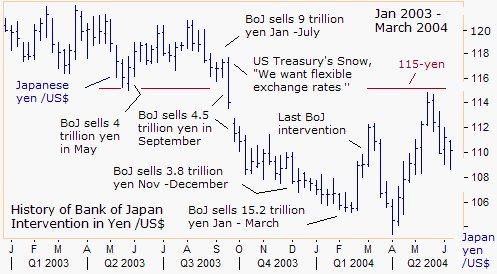
Currency traders were given the “green light” to knock the US dollar lower, and it quickly fell through the BoJ’s next line of defense at 110-yen. But Tokyo was determined to cushion the dollar’s downfall, and stepped up its intervention over the next six months, by selling 26 trillion yen and purchasing US$250 billion in the foreign exchange market between 104 and 110-yen.
But the massive BoJ intervention campaign on behalf of the dollar came to a halt on March 16th, 2004 after former Fed chief Greenspan critiqued the manipulative practice. “We are getting closer to the point where continued intervention at this scale will no longer meet the monetary policy needs of Japan,” he said on March 9th, 2004. US Treasury chief Snow added, “No currency can be regarded as strong if it relies on life support, is being propped up, by interventions.”
Since March 2004, the BoJ has stayed out of the FX market, the longest period that Tokyo has gone without getting its hands dirty since 1991. But that hasn’t stopped the practice of jawboning and verbal threats to guide the yen, when unruly currency traders get out of line with Tokyo’s target zones.
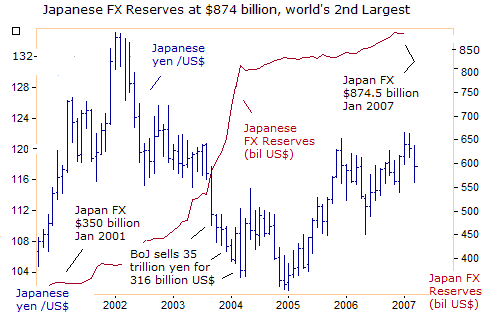
Since March 2004, Japan’s foreign currency reserves have grown by around $50 billion to a record $875 billion, mostly due to the appreciation of the Euro against the yen. About 65% of Japan’s FX reserves are in US dollars and 35% in Euros, so MoF warlords can enforce a floor under the yen at any point of its choosing, and keep a lid on the “yen carry” trade through massive intervention.
Angry US Democrats are demanding that Tokyo start boosting the yen in the FX market. “We believe that a weak yen is a reflection of Japanese government policy,” said Rep’s Charles Rangel, Barney Franks, John Dingell and Sander Levin on Feb 11th. “We urge the Japanese government to reverse their weak yen policy through concrete action. Japan should be selling the massive reserves it has accumulated, thereby changing the imbalances with the dollar and the Euro."
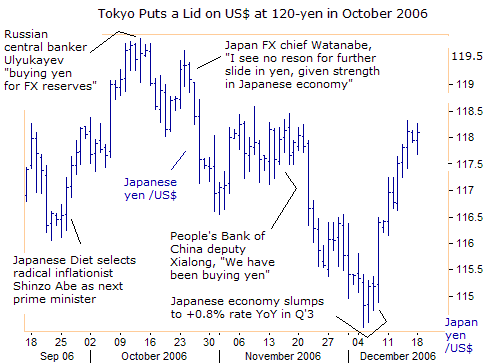
In October 2006, Japanese FX chief Hiroshi Watanabe put a lid on the US dollar rally near 120-yen and then triggered a slide to as low as 114.5-yen over the next six weeks, after telling reporters in New York, “I see no reason for a further deterioration in the yen given the strength in the Japanese economy.” Watanabe said he had “no fear of the Japanese economy tipping into recession any time in the next two years,” adding that Japan’s economy had become resilient to high oil prices.
But “yen carry” traders regrouped for another rally in the Euro and US dollar, and also pushed the yen to its lowest level in 21-years against a basket of currencies representing Japan’s largest trading partners. Japan’s ultra-low interest rates have created enormous bubbles in global stock markets, and have increased the risk of disorderly unwinding of global trade imbalances.
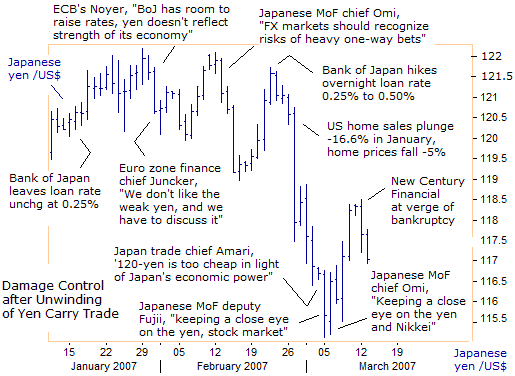
For a second time, Japanese MoF warlords put a lid on the dollar’s rally, this time to 122-yen last month, when the radical inflationist Prime minister, Shinzo Abe finally bowed to the European demand for a stronger yen. The Bank of Japan’s rate hike to 0.50% capped the dollar’s rally at 121.50-yen, and then trouble in the US housing sector, sent herds of “yen carry” traders scrambling for the exits at the same time.
The dollar was dealt the final hammer blow on March 5th, after Japanese trade minister Akira Amari said, “I’ve been thinking that 120-yen /dollar was too cheap in light of Japanese economic power,” he told a Fuji TV program. By the time US Treasury chief Paulson arrived in Tokyo for meeting with MoF chief Omi, the dollar was plunging to 115.25-yen, after guru Greenspan told a big ticket audience in Hong Kong that the US economy faced a 1:3 chance of a recession in 2007.
While MoF chief Omi huddled with US Treasury chief Paulson, Japanese deputy Finance Minister Hideto Fujii did damage control on March 5th, saying he was “keeping a close eye on moves in the stock and foreign exchange markets.”
Japanese MoF and US Treasury try to Rescue Global Stock markets
With all eyes focused on the world’s two most powerful figures in global finance huddled in Tokyo, to stitch a rescue package for the dollar and global stock markets, Japan’s Chief Cabinet Secretary Yasuhisa Shiozaki said, “As share prices have fallen worldwide, our stance is that we are closely watching, while keeping close contact with authorities from other countries,” he said.
But Japan’s near-zero interest rates and severely undervalued currency are at the root cause of financial market bubbles and distortions, says Eisuke Sakakibara, “Mr Yen” the former Japanese vice-minister for international finance in 1997-99. Mr Yen estimates the “yen carry” trade to be worth Y40 trillion ($430 billion), “it may be Y60 trillion or Y70 trillion, but I don’t think it matters now, it’s so large,” he said.
Sakakibara said it’s “worrying that nobody had any real idea of the scale of the yen carry trade, and traders, hedge funds and asset fund managers operating within it are accustomed to operating only in relatively calm market conditions. All the BoJ can do is to normalize Japanese interest rates at the earliest reasonable opportunity because the excess liquidity situation emanating from the Japanese monetary system needs to be changed as soon as possible,” he warned.
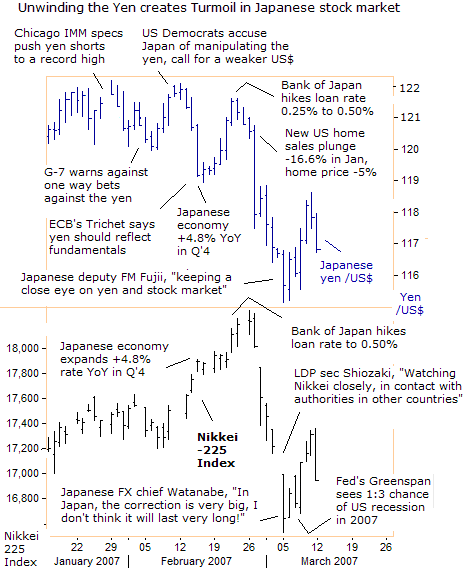
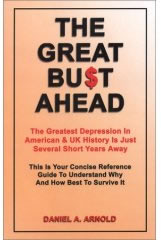 |
It seems like deja’vu all over again. After witnessing a 575-point plunge in the Nikkei-225 index, a 3.3% loss to 16,642 on March 5th, the powerful MoF warlord, Hiroshi Watanabe was asked for his opinion on the market. “We should be closely monitoring stock markets, but we don’t have any serious concern. In Japan the size of the correction is very big, but I don’t think it will last for very long.”
Sure enough, Watanabe’s comments put a floor under the Nikkei-225 on March 5th, similar to his rescue of the Nikkei-225’s rout in January 2006 from the Livedoor fiasco. Japanese traders have complete faith in Watanabe’s ability to put out fires and turn bearish markets around. Within a few days, the US dollar rebounded from a low of 115.25 on March 5th to as high as 118.50-yen, which triggered a 700-point rebound in the Nikkei-225 index.
US Treasury borrows MoF Script on Intervention
With MoF warlords putting a floor under the Nikkei-225 at 16,600, the US Plunge Protection Team (PPT) went into action on March 5 and 6th. Just 12-hours earlier, the share price of Goldman Sachs had plummeted by $5.75 to $190 per share, off 14.7% from its record highs set on Feb 22nd. Shares of New Century Financial NEW.N, the second-largest US home lender in the sub-prime market had plunged 70% the previous day, after some lenders refused to let it tap credit lines. Goldman Sachs is one of New Century’s lenders, along with Morgan Stanley and Citigroup.
Suddenly, the masters of the universe, with their slick and sophisticated Ponzi schemes requiring ever-larger infusions of cheap money were caught off guard. Bear Stearns, Goldman Sachs, Lehman Bros, Merrill Lynch and Morgan Stanley, which earned a record $24.5 billion in 2006, are exposed to sub-prime junk bonds, equaling 10% to 15% of their firm’s capital. Prices for credit-default swaps linked to their bonds traded at levels that equated to debt ratings of Baa2.
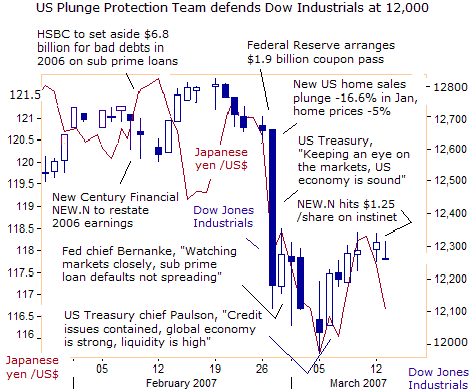
Speaking from Tokyo on March 5th, with the Dow Jones Industrials (DJI) teetering on the brink of the psychological 12,000 level and Goldman Sachs stock in need of some oxygen, PPT chief commander, Henry Paulson issued a buy signal, “Some of the credit issues are there, but they’re largely contained. The global economy is more than sound. It’s as strong in the last couple of years as I’ve seen in a lifetime. All the economies are growing, inflation is low, and liquidity is high,” Paulson declared. His comments triggered a powerful 160-point DJI rally by day’s end.
On Feb 27th, White House spokesman Tony Fratto said President Bush got a briefing over the phone from Paulson concerning the 416-point plunge in the DJI. “The president’s economic advisers are keeping an eye on the markets. We believe that the economic fundamentals in the US economy are sound,” said Fratto, borrowing the script from Tokyo’s Ministry of Finance.
Treasury spokeswoman Brooklyn McLaughlin said the President’s Working Group of Financial Markets (Plunge Protection Team) was monitoring the markets. “The president’s working group regularly monitors markets and will continue to do so,” McLaughlin said. The high-level group is made up of the Federal Reserve chairman, Treasury secretary, chairman of the Securities and Exchange Commission and chairman of the Commodity Futures Trading Commission.
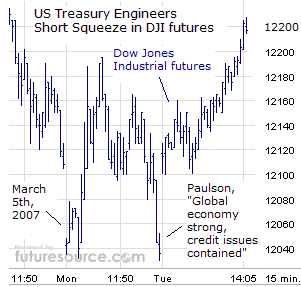
It’s very interesting to note that the Dow Jones Industrial futures market gapped 80-points higher after Paulson’s “don’t worry, be happy” comments in Tokyo, during the first 15-minutes of Asian trading on March 6th, putting a nasty squeeze on short sellers. On the previous day, March 5th, a large buyer entered the market to catch a falling knife, and lifted the DJI futures 140-points off their intra-day low within the second hour of Asian trading, when market conditions are usually thin. By week’s end, Goldman Sachs shares had recovered to $201 /sh.
Is there Intervention in the Stock Index futures markets?
Did Japan’s finance ministry and the US Treasury intervene in the stock index futures markets, to prevent panic free-falls, and engineer short squeeze rallies? Only their floor brokers know for sure. But intervention also includes jawboning, painting rosy scenarios, downplaying bad economic news and sub-prime mortgage defaults, and pushing money into the hands of securities dealers through coupon passes.
The US Plunge Protection Team (PPT) gave frazzled US investors a chance to catch their breath as the Dow Jones Industrials rebounded 226 points last week, after a 736-point plunge from its Feb 20th record high. But it has been almost four years since the Dow Industrials or the Standard & Poor’s 500 fell 10% from a high, which is an exceptionally long period without such a pullback. Not even Tokyo’s financial warlords have been able to put together such as winning streak!
The upcoming March 16th edition of Global Money Trends will examine the next likely move in the “yen carry” trade, with its implications for the global stock markets, commodities and gold. Was the 416-point plunge in the Dow Jones Industrials and sharp declines in other global stock markets the beginning of a bear market, or just a nasty correction in the a longer term bull market?
What are the signals to look for, to determine when the US Treasury is intervening in the stock market? Which foreign market is a top leading indicator of the next likely move for the global stock markets? What are Chinese and European central bankers saying about the correction in the global stock markets, and what is their next likely move on interest rates? The answers can be found in the upcoming March 16th edition of Global Money Trends. Subscribe today!
By Gary Dorsch, Editor, Global Money Trends newsletter
http://www.sirchartsalot.com/newsletters.php
Copyright © 2005-2007 SirChartsAlot, Inc. All rights reserved.
## “This article is just the Tip of the Iceberg” of what’s available in the Global Money Trends newsletter published around the 1st and 15th of each month in pdf format, and 30 pages in length. GMT collects a wide array of news and information from reputable sources, filters out the noise and distractions, and puts all the pieces of the global economic puzzle together into coherent snapshot analyses, with lots of cool charts showing the inter-relationships of markets and economic statistics from around the world.
Here's what you will receive with a subscription, Insightful analysis and predictions of, (1) top stock market indexes around the world, and US-listed Exchange Traded Funds (ETF’s) and closed-end country funds. (2) Commodities such as crude oil, copper, gold, silver, the CRB index, and gold mining and oil company indexes. (3) Foreign currencies such as, the Australian dollar, British pound, Euro, Japanese yen, and Canadian dollar. ($) Libor interest rates, global bond markets and their central bank monetary policies.
Subscribers will also receive Email Alerts, sent out in-between regular newsletter postings, when important information unfolds in the global markets.
A subscription to Global Money Trends is only $125 US dollars per year for 24 issues, including access to all back issues. Click on the following hyperlink, to order now, http://www.sirchartsalot.com/newsletters.php
© 2005-2022 http://www.MarketOracle.co.uk - The Market Oracle is a FREE Daily Financial Markets Analysis & Forecasting online publication.


